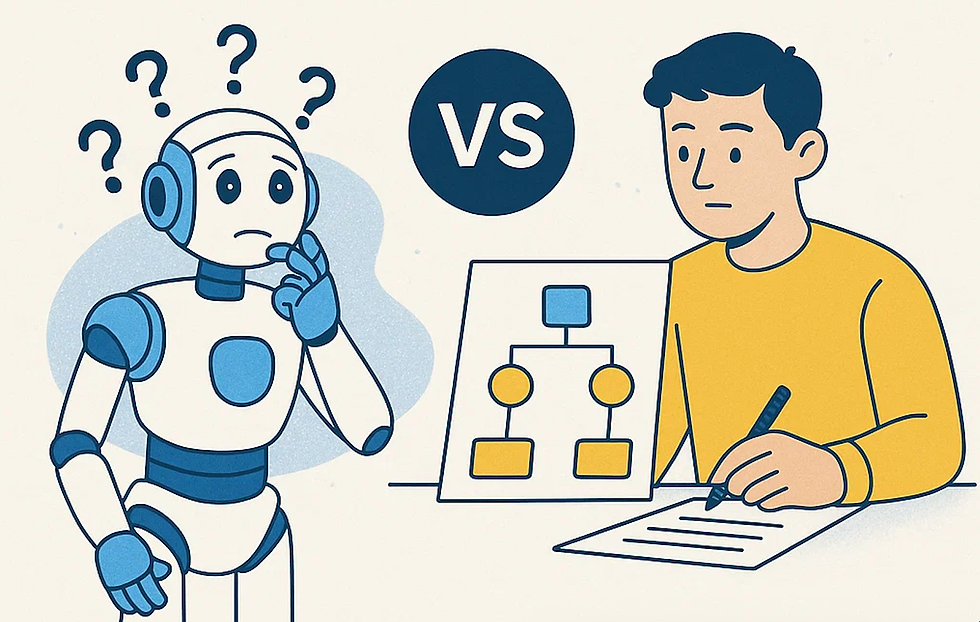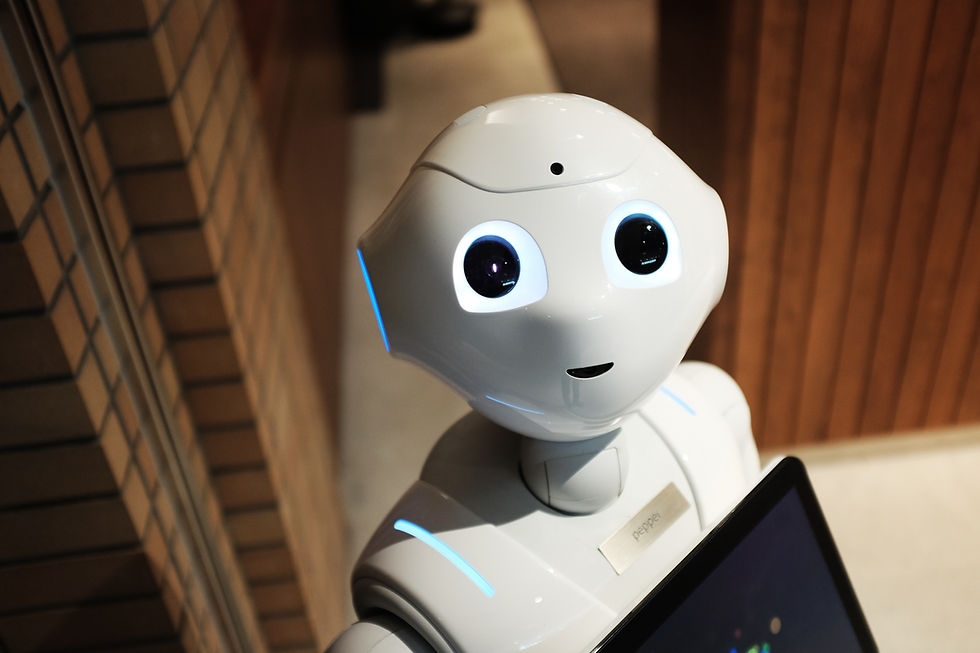Learning from the Past, Deciding for the Future: Case-Based Reasoning in Critical Domains
- Jaime Parra
- May 19
- 5 min read
Experiential Knowledge Transfer in Decision-Making
The mental process of noticing similar patterns between current and past problems is a basic part of human thinking. First named by Kling in 1971 and later explained in detail by Kolodner in 1992, case-based reasoning (CBR) has become a helpful way to support decisions in situations with unclear rules, many stakeholders, tight deadlines, and serious stakes. As Kolodner said, “CBR is strong because it can use past examples to explain decisions, just like human experts” (Kolodner, 1992).
CBR’s inner workings mirror how people learn from experience through four steps: finding similar past cases in memory; applying strategies that worked before; changing old methods to fit new needs; and saving the new experiences for future use. This cycle of learning and applying, often called the “4 Rs” (Retrieve, Reuse, Revise, Retain), is the core design for CBR systems in many settings.
Critical Application Domains: Implementation and Efficacy Analysis
Military Command and Decision Support Systems:
The military domain exemplifies high-stakes decision making. Historically, commanders have analyzed past battles to guide strategy; modern systems now formalize this through computational case-based reasoning (CBR). Today, CBR platforms can assist leaders by retrieving historical operations with similar terrain, force composition, or objectives; highlighting which tactics succeeded or failed; and tailoring those approaches to current capabilities and conditions.
Clinical Decision Support in Healthcare Environments:
Medical diagnosis and treatment planning naturally lend themselves to a case-based approach, as clinicians routinely recall comparable patient histories to inform their diagnosis. CBR-driven clinical support tools mirror this process by presenting precedent cases alongside algorithmic recommendations. Research indicates that practitioners place greater trust in artificial intelligence guidance when it is accompanied by the specific patient examples that underlie each suggestion—underscoring the importance of transparent, precedent-based reasoning in critical medical contexts.
Emergency Management Response Optimization:
Disaster response requires rapid, adaptive decision making under severe uncertainty, where static protocols often fall short. Wang et al. (2020) introduced a dynamic CBR framework for emergency management that retrieves analogous past incidents at key decision points; proposes interventions proven effective in those scenarios; and continuously updates its recommendations as events unfold. In simulated high-rise fire exercises, this approach improved evacuation timing by 37% and reduced resource allocation errors by 42% compared to conventional methods.

Comparative Advantages of CBR Methodologies in Decision Support Contexts
Despite big improvements in broad AI, CBR methods still offer special benefits in certain decision areas because of a few key features. First, CBR systems provide clear reasoning by basing their suggestions on real past cases rather than on patterns found only in statistical data. In practice, a CBR system will say, for example, that a recommended action comes from Operation Case that happened in 1992, which had similar land and force set-up to the current situation, while a general AI model might only note that “statistics show this tactic could work in desert settings.” This direct link from suggestion to an actual past case makes it easier to check and understand how a decision was reached.
Second, CBR’s structure lets it include deep, specialized knowledge, which proves vital in fields requiring narrow, technical skill—such as treating rare diseases or planning unique military tactics. By storing detailed, field-specific facts in its case library and search tools, a CBR system can draw comparisons with a level of accuracy that broad AI systems often cannot match because they lack the same depth of expertise
Third, CBR offers strong reliability where the stakes are high. Unlike some opaque AI systems that may accidentally invent details, CBR only retrieves verified historical cases, removing the risk of false or made-up information. When no close match is available, a well-designed CBR system will clearly state that no suitable case exists rather than guessing, and each step of its reasoning can be traced back to the original examples.
Finally, unlike many modern AI methods that often need huge amounts of data to work well, CBR can deliver solid decision support with much smaller collections of past cases. This advantage matters in areas where examples are scarce—such as secret military operations with few records, treatments for rare illnesses with limited patient histories, or new emergencies without clear past parallels—so that experts can still rely on past experience even when data are limited.
Augmenting Large Language Models with Case-Based Reasoning for Transparent, Adaptive, and Continual Learning
Modern large language models exhibit strong capabilities across a range of tasks, yet, as Hatalis, Christou, and Kondapalli (2025) have shown, they often falter when deep subject expertise, rapid adaptation, or clear explanations are required; by integrating case-based reasoning (CBR), such systems can draw on concrete past examples to justify each recommendation in a way that is easy to follow and verify, organize domain knowledge into focused case libraries that the model can tap into directly rather than relying solely on hidden statistical patterns, incorporate new insights immediately by adding fresh cases without the need for lengthy full-model retraining, and develop higher-order thinking skills—such as checking their own suggestions, identifying gaps in what they know, and seeking out further examples—thereby overcoming some of the key reasoning limits of standalone language models.
Hybrid Architecture Implementation: Integrating Case-Based Reasoning with Large Language Models for Robust Decision Support
We recently tried the hybrid architecture to make better decisions by joining the two powerful methods—Case-Based Reasoning (CBR), which uses past examples, and Large Language Models (LLMs), the same AI tools behind today’s chatbots. Our aim was to keep the trust you get from proven past cases while also getting the pattern-finding and explaining skills of modern AI.
What we saw is a system where each method helps the other. The CBR part ties every recommendation to real past outcomes, making sure each tip is backed by things that worked (or didn’t) in similar situations. At the same time, the LLM layer acts like a smart helper, finding small links between cases and turning complex ideas into plain language. It’s like having an expert friend who can look at many examples, spot hidden themes, and explain them in simple terms.
This teamwork has changed our decision support. By basing advice on real cases, we keep the clear link between suggestion and proof, which builds trust. Meanwhile, the AI layer adds deeper insight, showing not just what worked before but why it worked. When we tested this setup, it not only gave more accurate guidance but also gave more confidence, since we could see and check the link between the advice and the past cases.
Conclusion
Case-Based Reasoning represents a sophisticated methodological approach to decision support that mirrors fundamental human cognitive processes for experiential knowledge transfer. In critical decision domains characterized by rule ambiguity, temporal constraints, and high-consequence outcomes, CBR offers distinct advantages including epistemological transparency, domain-specific knowledge integration, operational reliability, and efficient learning from constrained empirical datasets.
The integration of CBR methodologies with a large language model presents a promising direction for advanced decision support systems that maintain the accountability of precedent-based reasoning while leveraging the pattern recognition capabilities of modern artificial intelligence. As decision environments continue to increase in complexity, hybrid approaches that combine the strengths of multiple reasoning paradigms may offer optimal solutions for critical decision support applications.



Comments